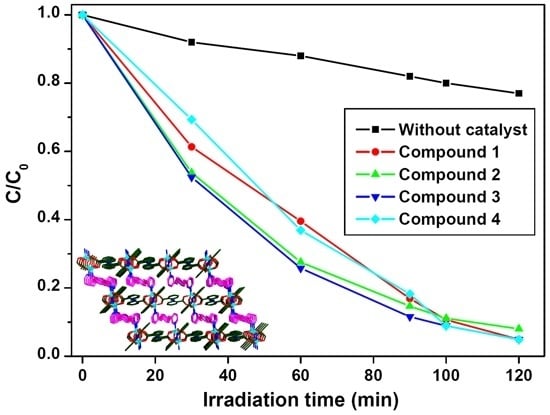Construction of Four Zn(II) Coordination Polymers Used as Catalysts for the Photodegradation of Organic Dyes in Water
Abstract
:1. Introduction
2. Experimental Section
2.1. Chemicals and Characterization
2.2. Synthesis
2.2.1. Synthesis of Compound 1
2.2.2. Synthesis of Compound 2
2.2.3. Synthesis of Compound 3
2.2.4. Synthesis of Compound 4
2.3. X-Ray Data Collection and Structure Determination
| Compounds | 1 | 2 | 3 | 4 |
|---|---|---|---|---|
| Empirical formula | C38H46N2O24Zn7 | C26H20N2O7Zn | C26H20N2O6Zn | C23H16N3O5Zn |
| Formula weight | 1372.50 | 537.83 | 521.81 | 479.76 |
| Crystal system | Triclinic | Triclinic | Monoclinic | Triclinic |
| Space group | Pī | Pī | P21 | Pī |
| a/Å | 10.231(2) | 9.6355(19) | 9.4819(19) | 10.259(2) |
| b/Å | 11.627(2) | 9.950(2) | 10.746(2) | 10.563(2) |
| c/Å | 12.602(3) | 13.936(3) | 11.348(2) | 10.846(2) |
| α/° | 114.18(3) | 78.20(3) | 90.00 | 106.60(3) |
| β/° | 110.45(3) | 84.53(3) | 92.56(3) | 96.99(3) |
| γ/° | 91.34(3) | 61.85(3) | 90.00 | 109.45(3) |
| V/Å3 | 1256.9(6) | 1153.2(4) | 1155.1(4) | 1030.9(4) |
| Z | 1 | 2 | 2 | 2 |
| Temperature/K | 296(2) | 296(2) | 296(2) | 296(2) |
| Dc/g·cm−3 | 1.813 | 1.549 | 1.500 | 1.545 |
| μ/Mo Kα, mm−1 | 3.366 | 1.117 | 1.109 | 1.233 |
| F(000) | 690.0 | 552.0 | 536.0 | 490.0 |
| Total reflections | 9665 | 8065 | 8178 | 7268 |
| Unique reflections(Rint) | 4406(0.0206) | 4054(0.0430) | 3961(0.0198) | 3618(0.0647) |
| No. of observations | 3784 | 3189 | 3758 | 2601 |
| No. of parameters | 327 | 325 | 317 | 289 |
| R1 a | 0.0282 | 0.0416 | 0.0232 | 0.0485 |
| wR2 b | 0.0710 | 0.1185 | 0.0525 | 0.1379 |
| GOF c | 1.030 | 1.054 | 1.038 | 1.036 |
2.4. Photocatalytic Activity Measurements
3. Results and Discussion
3.1. Synthetic and Spectral Aspects

3.2. Crystal Structure of 1
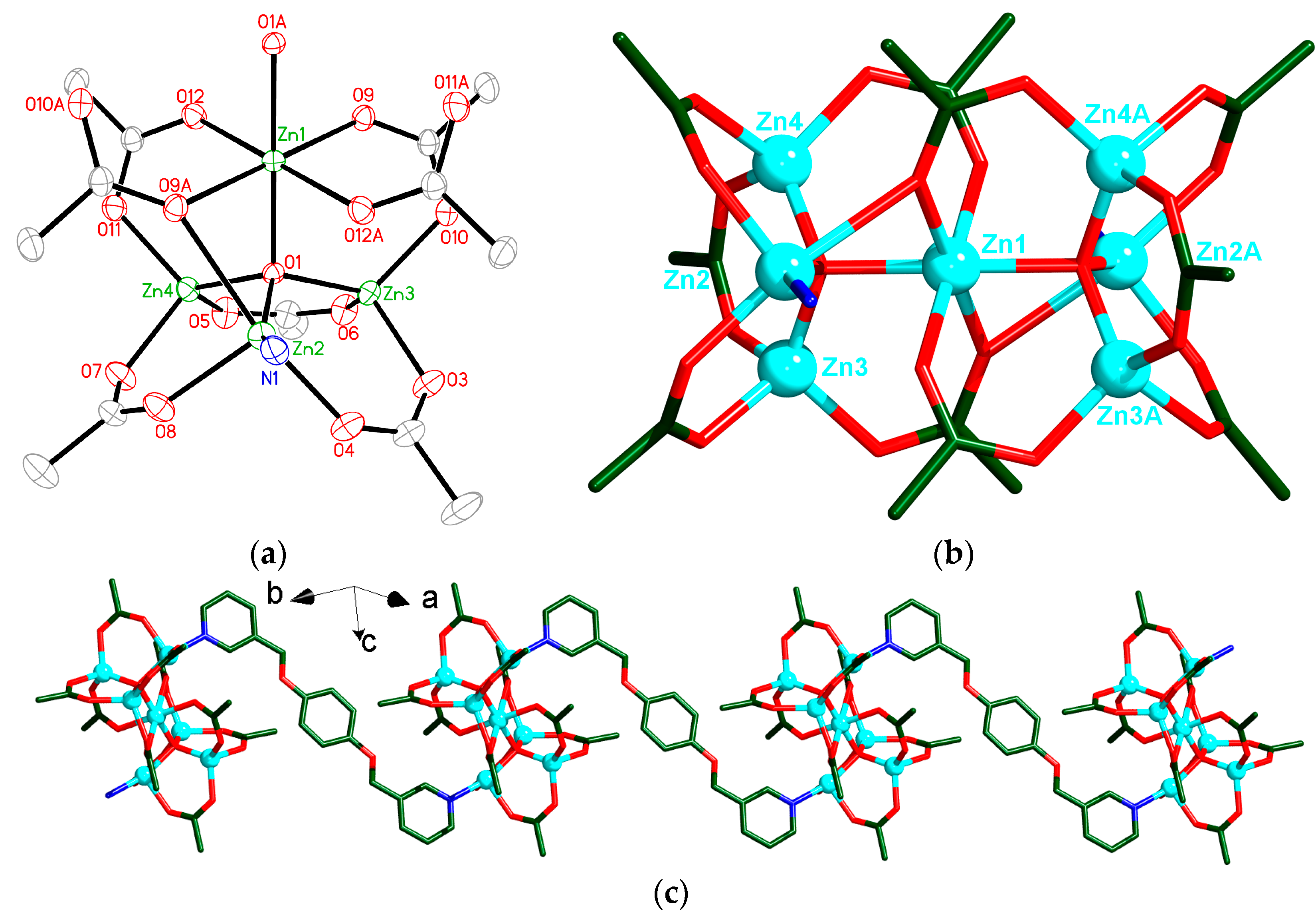
3.3. Crystal Structure of 2

3.4. Crystal Structure of 3
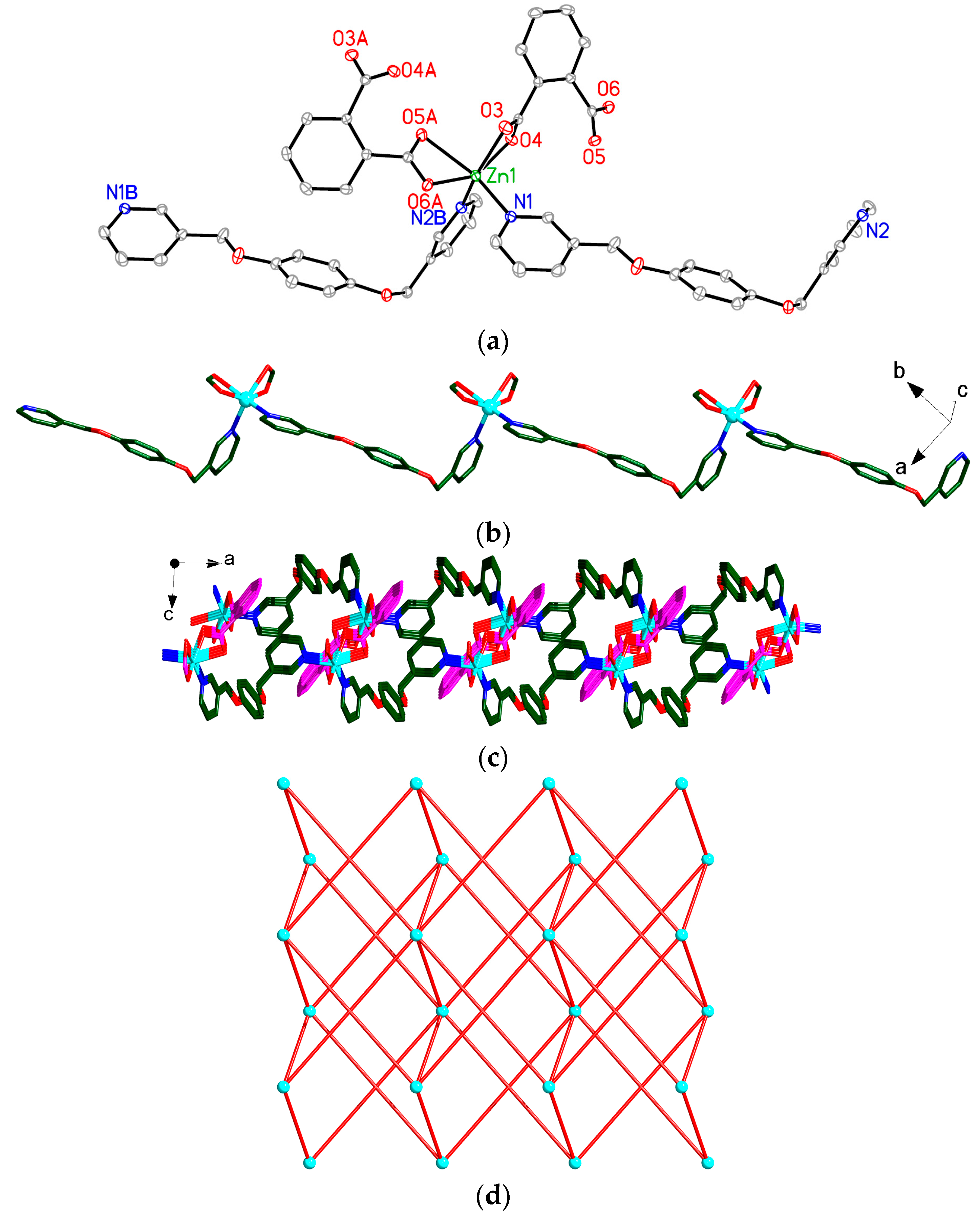
3.5. Crystal Structure of 4
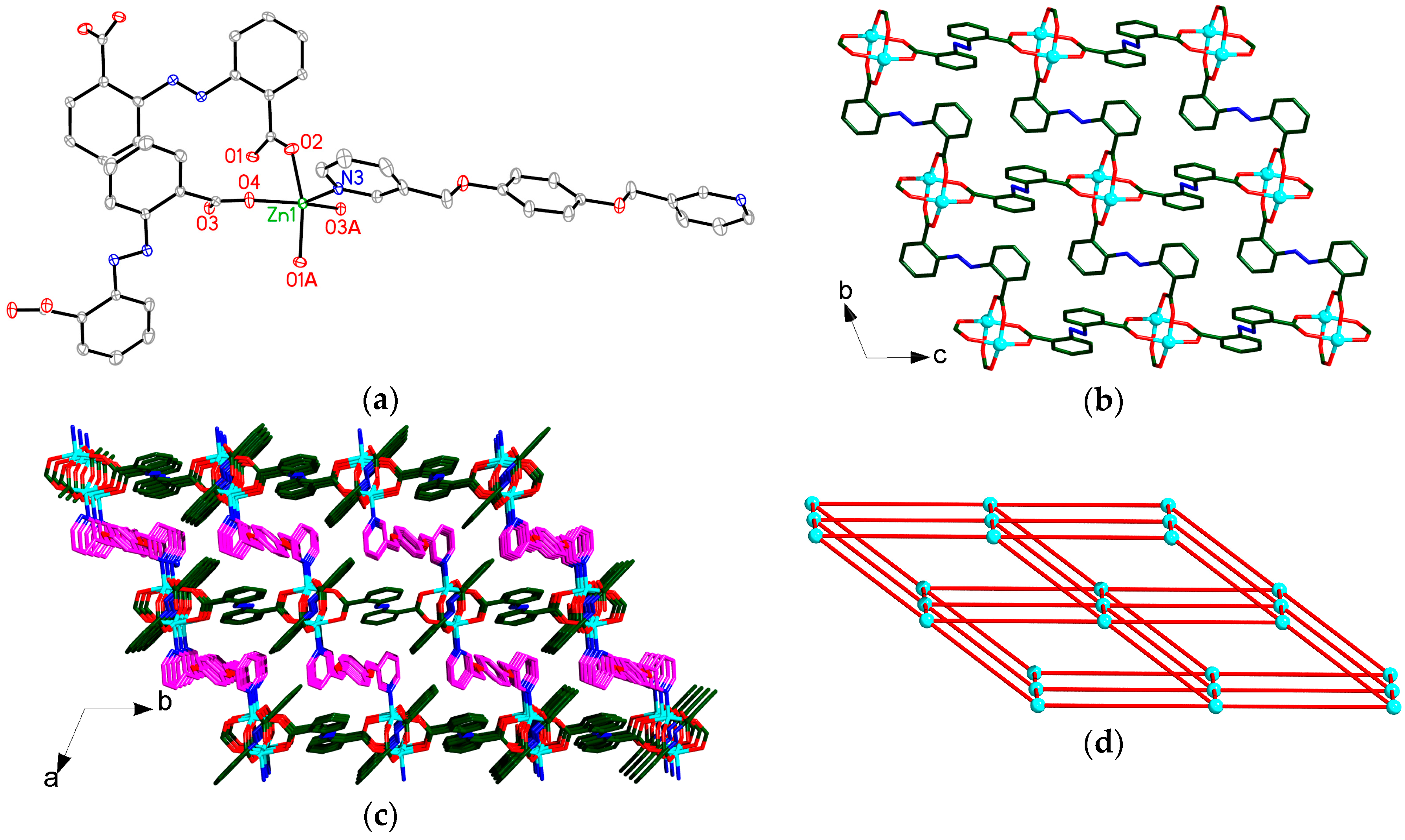
3.6. Thermal Property
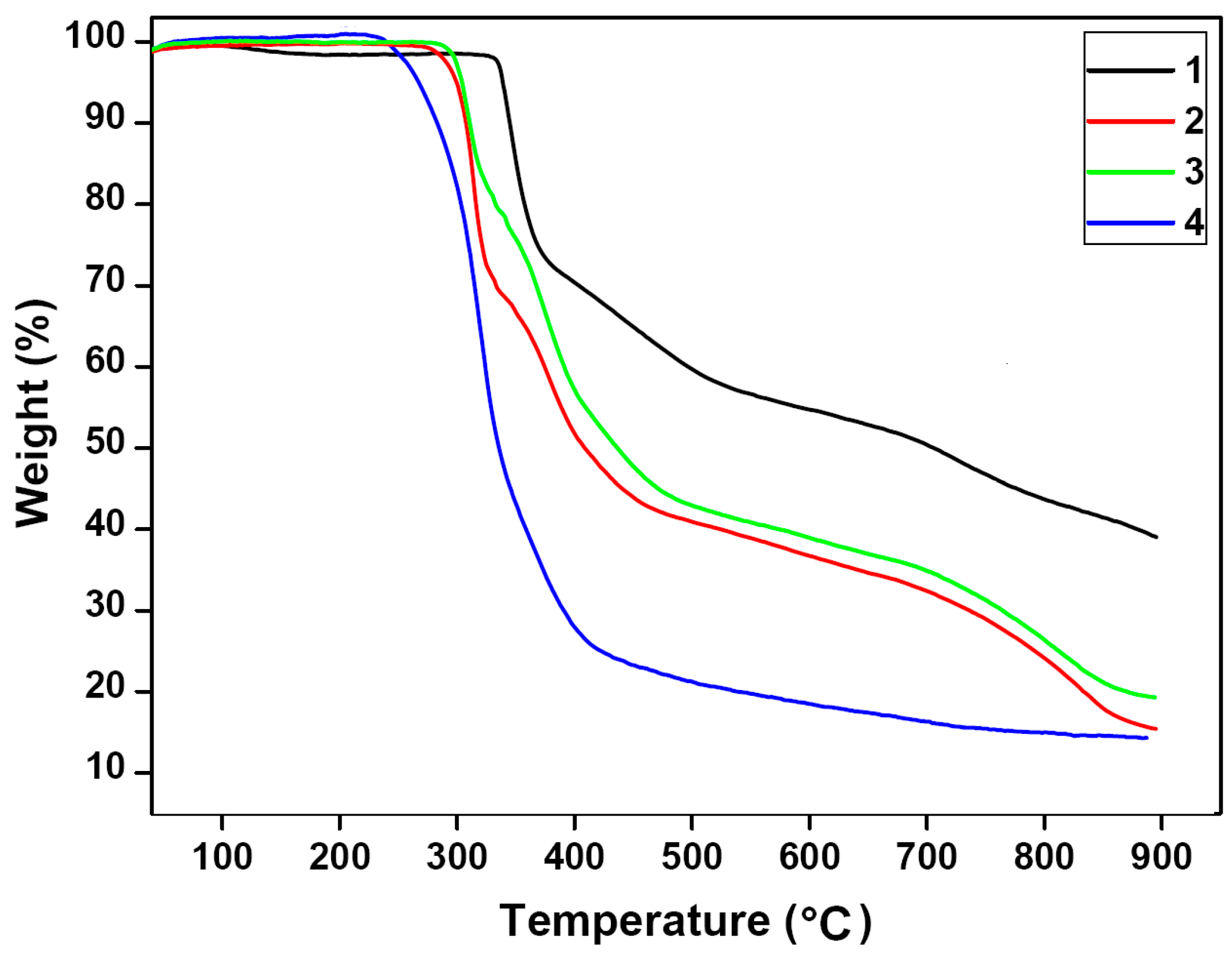
3.7. Photocatalytic Activity
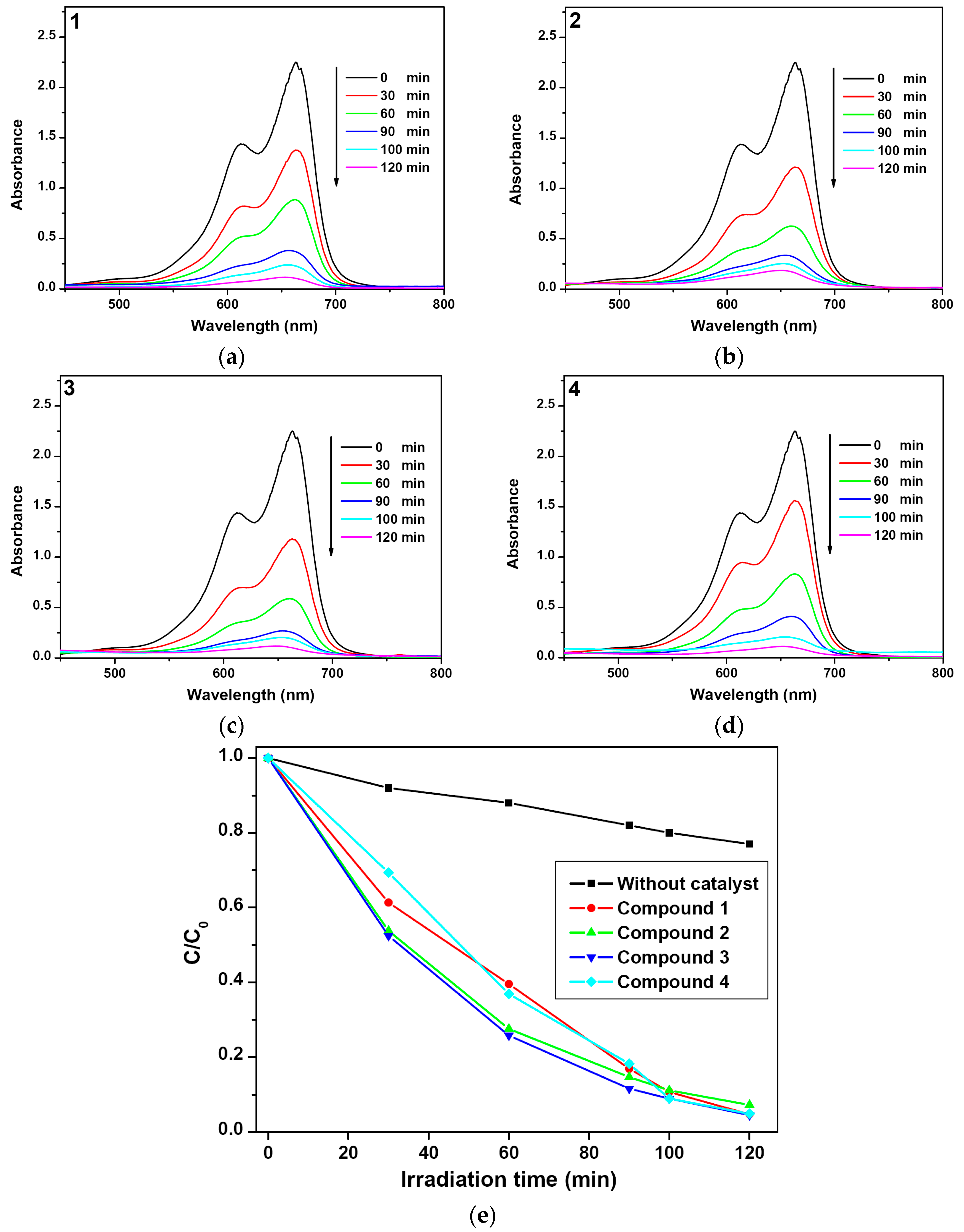
4. Conclusions
Supplementary Materials
Acknowledgments
Author Contributions
Conflicts of Interest
References
- Buchwalter, P.; Rosè, J.; Braunstein, P. Multimetallic catalysis based on heterometallic complexes and clusters. Chem. Rev. 2015, 115, 28–126. [Google Scholar] [CrossRef] [PubMed]
- Manna, K.; Zhang, T.; Lin, W. Postsynthetic metalation of bipyridyl-containing metal–organic frameworks for highly efficient catalytic organic transformations. J. Am. Chem. Soc. 2014, 136, 6566–6569. [Google Scholar] [CrossRef] [PubMed]
- Sun, D.; Ye, L.; Li, Z. Visible-light-assisted aerobic photocatalytic oxidation of amines to imines over NH2-MIL-125 (Ti). Appl. Catal. B Environ. 2015, 164, 428–432. [Google Scholar] [CrossRef]
- Wang, S.; Yao, W.; Lin, J.; Ding, Z.; Wang, X. Cobalt imidazolate metal–organic frameworks photosplit CO2 under mild reaction conditions. Angew. Chem. Int. Ed. 2014, 53, 1034–1038. [Google Scholar] [CrossRef] [PubMed]
- Yan, Y.; Yang, S.H.; Blake, A.J.; Schröder, M. Studies on metal–organic frameworks of Cu(II) with isophthalate linkers for hydrogen Storage. Acc. Chem. Res. 2014, 47, 296–307. [Google Scholar] [CrossRef] [PubMed]
- Sato, H.; Kosaka, W.; Matsuda, R.; Hori, A.; Hijikata, Y.; Belosludov, R.V.; Sakaki, S.; Takata, M.; Kitagawa, S. Self-accelerating CO sorption in a soft nanoporous crystal. Science 2014, 343, 167–170. [Google Scholar] [CrossRef] [PubMed]
- Farha, O.K.; Shultz, A.M.; Sarjeant, A.A.; Nguyen, S.T.; Hupp, J.T. Active-site-accessible, Porphyrinic metal–organic framework materials. J. Am. Chem. Soc. 2011, 133, 5652–5655. [Google Scholar] [CrossRef] [PubMed]
- Wu, P.Y.; He, C.; Wang, J.; Peng, X.J.; Li, X.Z.; An, Y.L.; Duan, C.Y. Photoactive chiral metal–organic frameworks for light-driven asymmetric α-alkylation of aldehydes. J. Am. Chem. Soc. 2012, 134, 14991–14999. [Google Scholar] [CrossRef] [PubMed]
- Zhao, Y.; Deng, D.S.; Ma, L.F.; Ji, B.M.; Wang, L.Y. A new copper-based metal–organic framework as a promising heterogeneous catalyst for chemo-and regio-selective enamination of β-ketoesters. Chem. Commun. 2013, 49, 10299–10301. [Google Scholar] [CrossRef] [PubMed]
- Li, H.X.; Zhao, W.; Li, H.Y.; Xu, Z.L.; Wang, W.X.; Lang, J.P. [Cu30I16(mtpmt)12(μ10-S4)]: An unusual 30-membered copper(I) cluster derived from the C–S bond cleavage and its use in heterogeneous catalysis. Chem. Commun. 2013, 49, 4259–4261. [Google Scholar] [CrossRef] [PubMed]
- Huang, S.L.; Lin, Y.J.; Hor, T.S.A.; Jin, G.X. Cp*Rh-based heterometallic metallarectangles: Size-dependent Borromean link structures and catalytic acyl transfer. J. Am. Chem. Soc. 2013, 135, 8125–8128. [Google Scholar] [CrossRef] [PubMed]
- Hu, Z.; Deibert, B.J.; Li, J. Luminescent metal–organic frameworks for chemical sensing and explosive detection. Chem. Soc. Rev. 2014, 43, 5815–5840. [Google Scholar] [CrossRef] [PubMed]
- O’Keeffe, M.; Yaghi, O.M. Deconstructing the crystal structures of metal–organic frameworks and related materials into their underlying nets. Chem. Rev. 2012, 112, 675–702. [Google Scholar] [CrossRef] [PubMed]
- Zhang, M.W.; Chen, Y.P.; Bosch, M.; Gentle, T.; Wang, K.C.; Feng, D.W.; Wang, Z.Y.U.; Zhou, H.C. Symmetry-guided synthesis of highly porous metal–organic frameworks with fluorite topology. Angew. Chem. Int. Ed. 2014, 53, 815–818. [Google Scholar] [CrossRef] [PubMed]
- Zhao, X.; Bu, X.H.; Wu, T.; Zheng, S.T.; Wang, L.; Feng, P.Y. Selective anion exchange with nanogated isoreticular positive metal-organic frameworks. Nat. Commun. 2013, 4, 2344. [Google Scholar] [CrossRef] [PubMed]
- Herm, Z.R.; Wiers, B.M.; Mason, J.A.; van Baten, J.M.; Hudson, M.R.; Zajdel, P.; Brown, C.M.; Masciocchi, N.; Krishna, R.; Long, J.R. Separation of hexane isomers in a metal-organic framework with triangular channels. Science 2013, 340, 960–964. [Google Scholar] [CrossRef] [PubMed]
- Liu, Y.; Yan, P.F.; Yu, Y.H.; Hou, G.F.; Gao, J.S.; Lu, J.Y. Syntheses, structures, and characterizations of a series of polymers constructed by two V-shape dipyridine-containing ligands. Cryst. Growth Des. 2010, 10, 1559–1568. [Google Scholar] [CrossRef]
- Oh, M.; Stern, C.L.; Mirkin, C.A. Coordination polymers from silver(I) and bifunctional pyridyl ligands. Inorg. Chem. 2005, 44, 2647–2653. [Google Scholar] [CrossRef] [PubMed]
- Liu, Y.; Yu, Y.H.; Liu, Y.F.; Hou, G.F.; Wang, X.D.; Wen, B.; Gao, J.S. A luminescent cage-Like complex constructed by bidentate pyridine-containing ligand and silver nitrate. Z. Anorg. Allg. Chem. 2013, 639, 193–196. [Google Scholar] [CrossRef]
- Steel, P.J.; Fitchett, C.M. Flexibility in the self-assembly of silver complexes: Coordination polymers from multi-armed pyridylmethyleneoxy ligands. Aust. J. Chem. 2013, 66, 443–451. [Google Scholar] [CrossRef]
- Li, L.J.; Qin, C.; Wang, X.L.; Wang, S.; Zhao, L.; Yang, G.S.; Wang, H.N.; Yuan, G.; Shao, K.Z.; Su, Z.M. pH variation induced construction of a series of entangled frameworks based on bi- and tri-metallic cores as nodes. CrystEngComm 2012, 14, 124–130. [Google Scholar] [CrossRef]
- Ma, W.; Li, J.; Tao, X.; He, J.; Xu, Y.; Yu, J.C.; Zhao, J. Efficient degradation of organic pollutants by using dioxygen activated by resin-exchanged iron(II) bipyridine under visible irradiation. Angew. Chem. 2003, 115, 1059–1062. [Google Scholar] [CrossRef]
- Liu, S.W.; Yu, J.G.; Jaroniec, M. Tunable photocatalytic selectivity of hollow TiO2 microspheres composed of anatase polyhedra with exposed {001} facets. J. Am. Chem. Soc. 2010, 132, 11914–11916. [Google Scholar] [CrossRef] [PubMed]
- Wang, H.H.; Yang, J.; Liu, Y.Y.; Song, S.Y.; Ma, J.F. Heterotrimetallic organic framework assembled with FeIII/BaII/NaI and schiff base: Structure and visible photocatalytic degradation of chlorophenols. Cryst. Growth Des. 2015, 15, 4986–4992. [Google Scholar] [CrossRef]
- Zhang, H.; Yu, K.; Lv, J.H.; Gong, L.H.; Wang, C.M.; Wang, C.X.; Sun, D.; Zhou, B.B. Organic-inorganic hybrid materials based on basket-like {Ca⊂P6Mo18O73} cages. Inorg. Chem. 2015, 54, 6744–6757. [Google Scholar] [CrossRef] [PubMed]
- Liu, L.; Ding, J.; Huang, C.; Li, M.; Hou, H.W.; Fan, Y.T. Polynuclear CdII polymers: Crystal structures, topologies, and the photodegradation for organic dye contaminants. Cryst. Growth Des. 2014, 14, 3035–3043. [Google Scholar] [CrossRef]
- Wu, X.Y.; Qi, H.X.; Ning, J.J.; Wang, J.F.; Ren, Z.G.; Lang, J.P. One silver(I)/tetraphosphine coordination polymer showing good catalytic performance in the photodegradation of nitroaromatics in aqueous solution. Appl. Catal. B Environ. 2015, 168–169, 98–104. [Google Scholar] [CrossRef]
- Liu, L.; Ding, J.; Li, M.; Lv, X.F.; Wu, J.; Hou, H.W.; Fan, Y.T. Structural variability, topological analysis and photocatalytic properties of neoteric Cd(II) coordination polymers based on semirigid bis(thiazolylbenzimidazole) and different types of carboxylic acid linkers. Dalton Trans. 2014, 43, 12790–12799. [Google Scholar] [CrossRef] [PubMed]
- Wen, L.L.; Zhao, J.B.; Lv, K.L.; Wu, Y.H.; Deng, K.J.; Leng, X.K.; Li, D.F. Visible-light-driven photocatalysts of metal–organic frameworks derived from multi-carboxylic acid and imidazole-based spacer. Cryst. Growth Des. 2012, 12, 1603–1612. [Google Scholar] [CrossRef]
- Chen, Y.Q.; Liu, S.J.; Li, Y.W.; Li, G.R.; He, K.H.; Qu, Y.K.; Hu, T.L.; Bu, X.H. A two-fold interpenetrated coordination framework with a rare (3,6)-connected loh1 topology: Magnetic properties and photocatalytic behavior. Cryst. Growth Des. 2012, 12, 5426–5431. [Google Scholar] [CrossRef]
- Wen, T.; Zhang, D.X.; Zhang, J. Two-dimensional copper(I) coordination polymer materials as photocatalysts for the degradation of organic dyes. Inorg. Chem. 2013, 52, 12–14. [Google Scholar] [CrossRef] [PubMed]
- Wang, F.; Liu, Z.S.; Yang, H.; Tan, Y.X.; Zhang, J. Hybrid zeolitic imidazolate frameworks with catalytically active TO4 building blocks. Angew. Chem. Int. Ed. 2011, 50, 450–453. [Google Scholar] [CrossRef] [PubMed]
- Hou, Y.L.; Sun, R.W.Y.; Zhou, X.P.; Wang, J.H.; Li, D. A copper(I)/copper(II)-salen coordination polymer as a bimetallic catalyst for three-component strecker reactions and degradation of organic dyes. Chem. Commun. 2014, 50, 2295–2297. [Google Scholar] [CrossRef] [PubMed]
- Meng, W.; Xu, Z.Q.; Ding, J.; Wu, D.Q.; Han, X.; Hou, H.W.; Fan, Y.T. A systematic research on the synthesis, structures, and application in photocatalysis of cluster-based coordination complexes. Cryst. Growth Des. 2014, 14, 730–738. [Google Scholar] [CrossRef]
- Dai, M.; Su, X.R.; Wang, X.; Wu, B.; Ren, Z.G.; Zhou, X.; Lang, J.P. Three zinc(II) coordination polymers based on tetrakis(4-pyridyl)cyclobutane and naphthalenedicarboxylate linkers: Solvothermal syntheses, structures, and photocatalytic properties. Cryst. Growth Des. 2014, 14, 240–248. [Google Scholar] [CrossRef]
- Fu, H.R.; Kang, Y.; Zhang, J. Highly selective sorption of small hydrocarbons and photocatalytic properties of three metal–organic frameworks based on tris(4-(1H‑imidazol-1-yl)phenyl)amine ligand. Inorg. Chem. 2014, 53, 4209–4214. [Google Scholar] [CrossRef] [PubMed]
- Hu, F.L.; Shi, Y.X.; Chen, H.H.; Lang, J.P. A Zn(II) coordination polymer and its photocycloaddition product: Syntheses, structures, selective luminescence sensing of iron(III) ions and selective absorption of dyes. Dalton Trans. 2015, 44, 18795–18803. [Google Scholar] [CrossRef] [PubMed]
- Liu, L.L.; Yu, C.X.; Li, Y.R.; Han, J.J.; Ma, F.J.; Ma, L.F. Positional isomeric effect on the structural variation of Cd(II) coordination polymers based on flexible linear/V-shaped bipyridyl benzene ligands. CrystEngComm 2015, 17, 653–664. [Google Scholar] [CrossRef]
- Liu, L.L.; Yu, C.X.; Sun, J.; Meng, P.P.; Ma, F.J.; Du, J.M.; Ma, L.F. Three coordination polymers constructed from various polynuclear clusters spaced by 2,2′-azodibenzoic acid: Syntheses and fluorescent properties. Dalton Trans. 2014, 43, 2915–2924. [Google Scholar] [CrossRef] [PubMed]
- Liu, L.L.; Yu, C.X.; Zhou, Y.; Sun, J.; Meng, P.P.; Liu, D.; Sa, R.J. Three Cd(II) coordination polymers assembled by flexible 2,2′-azodibenzoic acid and N-donor auxiliary ligand: Structural diversities and luminescent properties. Inorg. Chem. Commun. 2014, 40, 194–199. [Google Scholar] [CrossRef]
- Liu, L.L.; Yu, C.X.; Ma, F.J.; Li, Y.R.; Han, J.J.; Lin, L.; Ma, L.F. Structural diversity and photocatalytic properties of Cd(II) coordination polymers constructed by a flexible V-shaped bipyridyl benzene ligand and dicarboxylate derivatives. Dalton Trans. 2015, 44, 1636–1645. [Google Scholar] [CrossRef] [PubMed]
- Sheldrick, G.M. SHELXS-97 and SHELXL-97, Program for X-ray Crystal Structure Solution; University of Göettingen: Göettingen, Germany, 1997. [Google Scholar]
- Wells, A.F. Three-Dimensional Nets and Polyhedra; Wiley-Interscience: New York, NY, USA, 1977. [Google Scholar]
- Wee, L.H.; Janssens, N.; Sree, S.P.; Wiktor, C.; Gobechiya, E.; Fischer, R.A.; Kirschhock, C.E.A.; Martens, J.A. Local transformation of ZIF-8 powders and coatings into ZnO nanorods for photocatalytic application. Nanoscale 2014, 6, 2056–2060. [Google Scholar] [CrossRef] [PubMed]
- Li, D.X.; Ni, C.Y.; Chen, M.M.; Dai, M.; Zhang, W.H.; Yan, W.Y.; Qi, H.X.; Ren, Z.G.; Lang, J.P. Construction of Cd(II) coordination polymers used as catalysts for the photodegradation of organic dyes in polluted water. CrystEngComm 2014, 16, 2158–2167. [Google Scholar] [CrossRef]
- Bordiga, S.; Lamberti, C.; Ricchiardi, G.; Regli, L.; Bonino, F.; Damin, A.; Lillerud, K.P.; Bjorgen, M.; Zecchin, A. Electronic and vibrational properties of a MOF-5 metal–organic framework: ZnO quantum dot behavior. Chem. Commun. 2004, 20, 2300–2301. [Google Scholar] [CrossRef] [PubMed]
© 2016 by the authors. Licensee MDPI, Basel, Switzerland. This article is an open access article distributed under the terms and conditions of the Creative Commons by Attribution (CC-BY) license ( http://creativecommons.org/licenses/by/4.0/).
Share and Cite
Liu, L.-L.; Yu, C.-X.; Zhou, W.; Zhang, Q.-G.; Liu, S.-M.; Shi, Y.-F. Construction of Four Zn(II) Coordination Polymers Used as Catalysts for the Photodegradation of Organic Dyes in Water. Polymers 2016, 8, 3. https://doi.org/10.3390/polym8010003
Liu L-L, Yu C-X, Zhou W, Zhang Q-G, Liu S-M, Shi Y-F. Construction of Four Zn(II) Coordination Polymers Used as Catalysts for the Photodegradation of Organic Dyes in Water. Polymers. 2016; 8(1):3. https://doi.org/10.3390/polym8010003
Chicago/Turabian StyleLiu, Lei-Lei, Cai-Xia Yu, Wei Zhou, Qi-Gui Zhang, Shi-Min Liu, and Yun-Feng Shi. 2016. "Construction of Four Zn(II) Coordination Polymers Used as Catalysts for the Photodegradation of Organic Dyes in Water" Polymers 8, no. 1: 3. https://doi.org/10.3390/polym8010003
APA StyleLiu, L.-L., Yu, C.-X., Zhou, W., Zhang, Q.-G., Liu, S.-M., & Shi, Y.-F. (2016). Construction of Four Zn(II) Coordination Polymers Used as Catalysts for the Photodegradation of Organic Dyes in Water. Polymers, 8(1), 3. https://doi.org/10.3390/polym8010003





